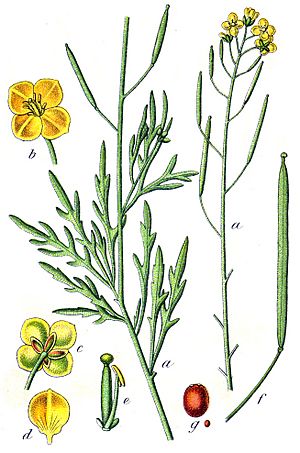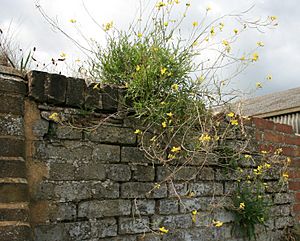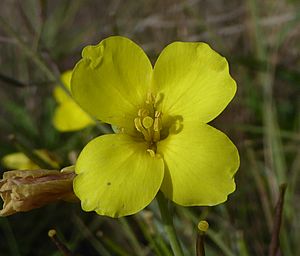Perennial wall-rocket facts for kids
Quick facts for kids Perennial wall-rocket |
|
|---|---|
 |
|
| Scientific classification | |
| Genus: |
Diplotaxis (plant)
|
| Species: |
tenuifolia
|
Diplotaxis tenuifolia is a type of flowering plant in the mustard family. It's often called perennial wall-rocket. This plant originally grew in Europe and West Asia, usually in places where the ground has been disturbed, like roadsides. Now, you can find it in many temperate parts of the world because it has spread and grown naturally there.
In recent years, people have started growing it more often for its leaves, which are used in salads. In Britain, it's known as wild rocket, and in the US, it's called arugula. It looks quite similar to another plant called garden rocket, which is also used in salads.
What Does it Look Like?
Perennial wall-rocket is a herb that can grow up to 1.3 meters (about 4 feet) tall. It has a solid stem and branches that spread out. The plant is smooth, meaning it doesn't have hairs.
Its leaves can be up to 12 cm (about 5 inches) long and are often quite thick. They are usually deeply divided, almost like feathers. These leaves have a peppery taste and a distinct smell.
The plant flowers from spring to autumn, sometimes even into winter in warm places. Its flowers grow in a long cluster, up to 30 cm (12 inches) long, with up to 30 flowers. Each flower has four bright yellow petals, which can be up to 15 mm long. It also has four yellow-brown sepals (leaf-like parts that protect the bud). Each flower has six stamens (the parts that produce pollen) and one style (part of the female reproductive organ).
The fruit is a straight, flat pod, called a silique, which can be up to five centimeters (2 inches) long. A helpful way to identify this plant is to look for a short stalk, about 2 mm long, just below the pod. The seeds inside the pod are arranged in two rows. This double row of seeds is a special feature of the Diplotaxis group of plants.
Plant Names and History
The original name for perennial wall-rocket was Sisymbrium tenuifolium, given by a famous scientist named Linnaeus in 1755. Later, in 1821, another scientist named de Candolle moved it to a new group called Diplotaxis. Over the years, it has been given many other names, which shows how complicated it can be to classify plants!
The name Diplotaxis comes from Ancient Greek words. "Diplos" means "twofold" or "double," and "tasso" means "to put in order" or "to arrange in a line." This refers to the double row of seeds found in each part of the fruit. The second part of its name, tenuifolia, simply means "narrow-leafed."
The common name "rocket" comes from the Italian word "ruchetta," which describes various plants in the mustard family. This plant is also sometimes called wild rocket, sand rocket, or white rocket. Its seeds are sometimes sold as "wild Italian arugula."
How to Tell it Apart
If you're in Britain, you might confuse it with another plant called annual wall-rocket. However, perennial wall-rocket doesn't have a cluster of leaves at its base. Also, its leaves are divided more deeply, and its fruit has a short stalk just below the pod.
A key feature to tell Diplotaxis plants apart from most other mustard family plants is the double row of seeds in each part of their fruit.
Where it Grows
This plant is originally from parts of Europe, reaching as far east as Turkey and Syria. It used to grow in Morocco and Algeria but is no longer found there. However, it has been introduced to many other places around the world. These include Cyprus, Japan, Australia, New Zealand, Canada, the United States, and parts of South America like Argentina.
Within Europe, its native range covers much of France, Italy, and the western Balkans. It has also spread further north in Europe, especially in industrial areas and ports. In places like England and Wales, it is now well-established. It has also been introduced to Central Europe, including Switzerland, Austria, Germany, and Poland.
How it Lives
Perennial wall-rocket is a plant that likes to grow in disturbed areas, such as roadsides and waste ground. It prefers places with full sunlight and needs soil that is moderately damp and slightly alkaline (not too acidic). It can even grow in places with a little salt, like the upper parts of beaches or along roads where salt is used to melt ice. In Spain, it can be found growing at heights of up to 800 meters (about 2,600 feet).
Many insects like to feed on perennial wall-rocket. In Britain, 11 different insect species are known to eat it. Five of these are weevils, which are small beetles. For example, the cabbage leaf weevil eats the leaves and stems. Other weevil larvae can make galls (small growths) on the plant's leaf stalks or feed on its roots.
Four types of flies also feed on this plant. Some midge larvae can cause the stems, leaves, and flowers to become twisted or unable to produce seeds. The brassica pod midge can damage the developing seedpods, which is a problem for crops like rapeseed.
Finally, three types of butterflies and moths are known to feed on perennial wall-rocket. The common cabbage white butterfly larvae eat the leaves and stems. Other small moth larvae feed in the flowerheads or on various parts of the plant.
What it's Used For
Young leaves of perennial wall-rocket are grown all over the world for use in salads. They are often mixed with other young leaves to create a "mesclun"-style salad. These leaves have become very popular because of their unique taste and texture.
The leaves are full of good things for you, like ascorbic acid (Vitamin C), carotenoids (which the body turns into Vitamin A), and polyphenols. They also contain special compounds called glucosinolates, which give the plant its strong, pungent flavor. When you chew the leaves, these compounds can turn into other substances that are good for your health.
Long ago, in a medical book called Treatments for Women, "wild rocket cooked in wine" was mentioned as a remedy for certain health issues.
Images for kids
See also
 In Spanish: Flor amarilla para niños
In Spanish: Flor amarilla para niños








